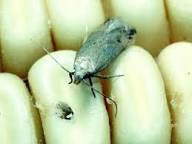Harvested produce represents the culmination of farmers’ efforts in maintaining crops in the field. Thus, it must be stored for some time before consumption
During storage, harvested produce is frequently attacked and damaged by organisms such as microorganisms, mites, insects, rodents, and birds.
Damage caused by pest organisms to stored produce is significant because it occurs after harvest, leaving no opportunity for compensation.
Postharvest pest problems are more severe in tropical storage environments than in temperate climates due to optimal temperature and relative humidity conditions that favor pest development in the tropics.
Many aspects of pest development and behavior are influenced by environmental physical conditions. For instance, temperature significantly affects insect development.
At low temperatures, insect development is slow, mortality is relatively high, and individual insect activity is reduced, resulting in low population growth rates.
As temperature increases, insect development and biological activity accelerate, mortality decreases, and population growth rates rise significantly.
All insect species have an optimum temperature range (25–30°C) at which population growth reaches its maximum. Beyond this optimum, while development and activity of individual insects increase, mortality rises, and population growth declines.
The effect of temperature on the biological activity of storage pests is closely tied to ambient humidity, which varies considerably by region and season. Under low relative humidity, population growth for most storage pests slows.
Thus, high temperatures and low relative humidity can be leveraged to control storage pests. This article examines the various organisms that cause damage to stored agricultural produce
.Read Also: Challenges and Potential of Snail Farming
Key Pests Affecting Stored Agricultural Commodities

Pest organisms attacking stored commodities include microorganisms (microflora such as bacteria and fungi), mites, insects, rodents, and birds. Fungi are likely second only to insects as agents of deterioration and loss in stored products worldwide.
Fungi, particularly molds, are the primary factor limiting the storability of intermediate-moisture grains. Fungi associated with stored foods and agricultural commodities include Aspergillus species, Curvularia species, Fusarium species, Penicillium species, Verticillium species, Alternaria species, Cladosporium species, and others.
Impact of Fungi and Bacteria on Stored Grains
Fungi growing on or in stored grains cause numerous losses, including decreased germinability; discoloration of parts (usually the germ or embryo) or the entire seed; heating and mustiness; biochemical changes in fatty acids, reducing sugars, and respiration; production of mycotoxins, which may be harmful to humans and animals if consumed; and weight loss.
Fungi reduce product quality through discoloration or altered taste (bad flavor or smell) and diminish nutritive value. By invading the embryo, fungi impair germinability, often leading to rapid embryo death.
Damage to stored produce by microflora includes:
- ‘Damp grain heating,’ which causes caking, fermentation, or rotting
- Reduction in food value due to degradation of glucids (carbohydrates) and protids (proteins and lipids)
- Musty smell
- Damage to the germ, reducing germinability
- Development of mycotoxins or poisons, e.g., aflatoxin in groundnuts, due to fungal metabolism
- Encouragement of mite infestations, which are fungivorous
Read Also: The Complete Guide to Snail Farming Techniques
Insects and Vertebrate Pests Damaging Stored Agricultural Produce

Storage insect pests are classified based on feeding behavior into primary, secondary, fungus feeders, and scavengers. Primary pests can penetrate the intact outer coats of grains, seeds, and other undamaged produce, including the cowpea bruchid Callosobruchus maculatus, Ephestia spp., Trogoderma spp., Rhizopertha dominica, Prostephanus truncatus, Sitophilus spp., Dermestes spp., and the kola beetle.
Secondary pests feed only on grains already damaged by primary pests or during harvest, such as beetles like Cryptolestes spp., Tribolium spp., and Oryzaephilus spp. Some pests are host-specific: Bruchidae (Callosobruchus spp.) attack only legume seeds, Sitophilus spp. target cereal grains, and Dermestes spp. are confined to animal and dried proteinaceous commodities.
Major storage pests in the tropics include beetles (order Coleoptera) from various families, a few moths (order Lepidoptera, family Pyralidae), mites, rats, mice, and birds that feed on produce during drying.
Affected produce includes cereal grains, flours, dried pulses (usually shelled), nuts, oilseeds, other seeds and cakes, dried fruits and berries, dried leaves, dried roots and tubers, animal feeds, and feed ingredients.
Postharvest pest problems may begin once crops reach physiological maturity and undergo natural dehydration in the field, e.g., Sitophilus zeamais.
Losses and damage by insects and mites manifest directly through consumption of commodities (e.g., endosperm in cereal grains or cotyledon in pulse seeds), embryo death, and contamination with live insects, insect fragments, exuviae, excreta, and chemical secretions.
Indirect damage includes dry grain heating, moisture migration, and sprouting. Dry grain heating results from insect respiration within the grain mass, causing localized ‘hot spots’ or general temperature gradients and convection currents.
Rodents directly consume stored food commodities. A single average-sized rat may consume at least 500g of grain per month. Rodents are economically significant in bulk grain storage due to contamination with carcasses, hair, feces, and urine, and they may cause serious damage to storage structures.
Birds also damage stored produce, particularly cereals, through direct consumption. Their economic impact is largely tied to contamination with droppings, feathers, or materials used in nest-building. Additionally, bird nests and feces may provide harborage and breeding sites for insects and mites.
Do you have any questions, suggestions, or contributions? If so, please feel free to use the comment box below to share your thoughts. We also encourage you to kindly share this information with others who might benefit from it. Since we can’t reach everyone at once, we truly appreciate your help in spreading the word. Thank you so much for your support and for sharing!
Frequently Asked Questions
We will update this section soon.

